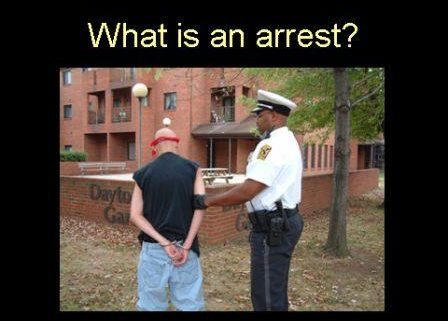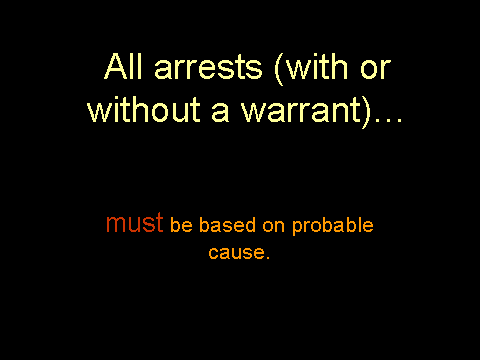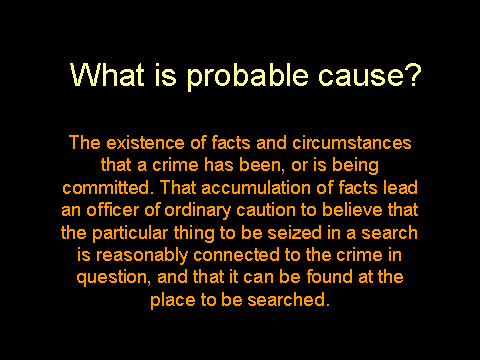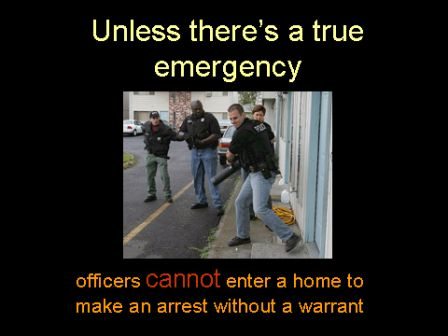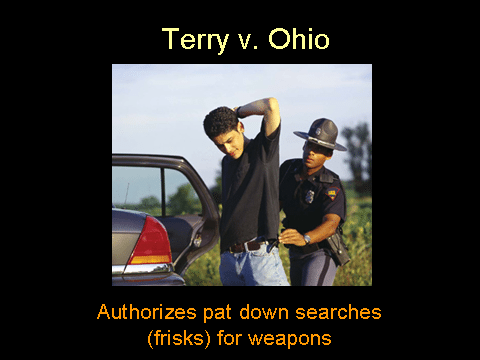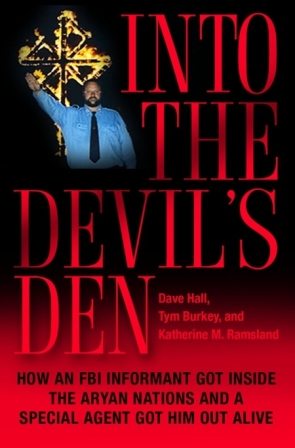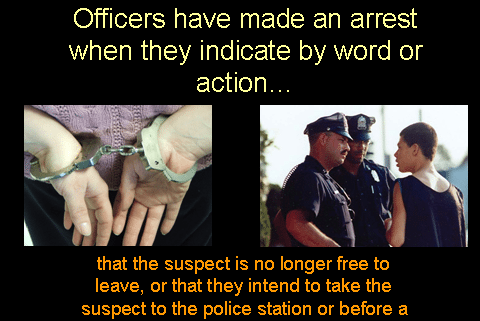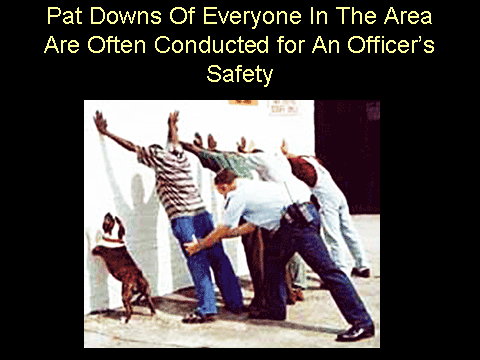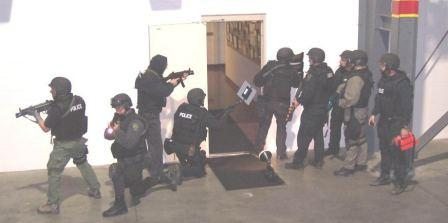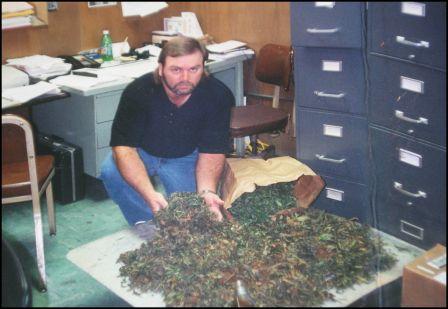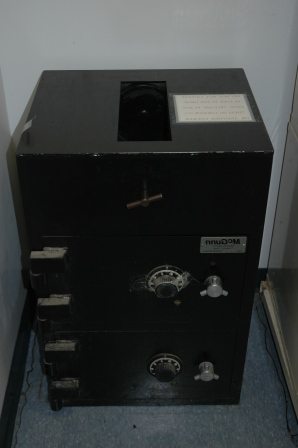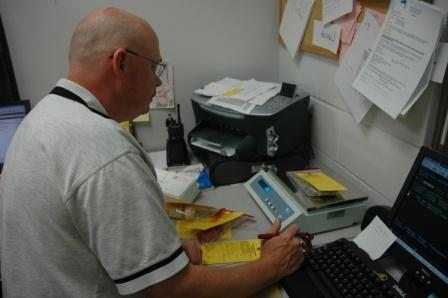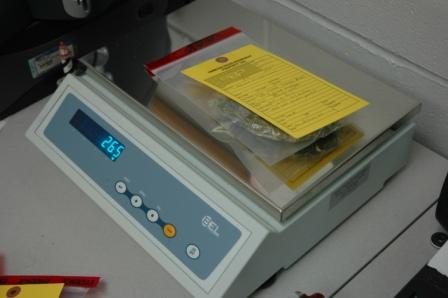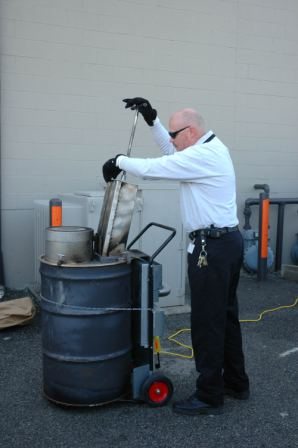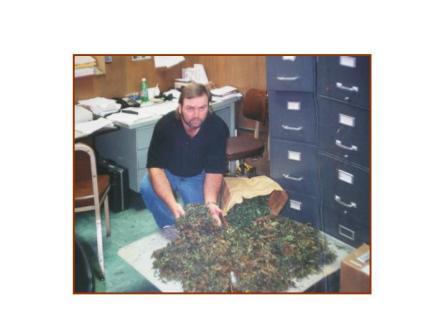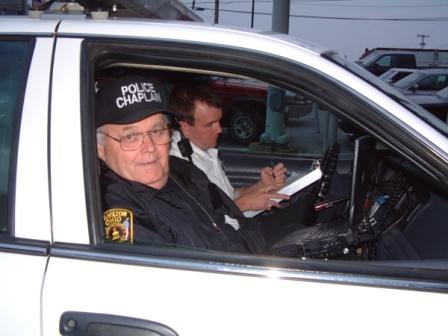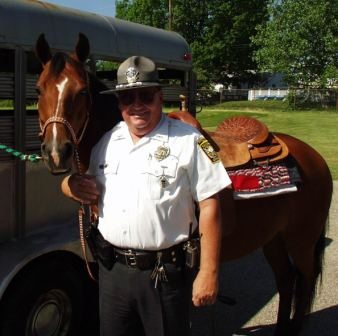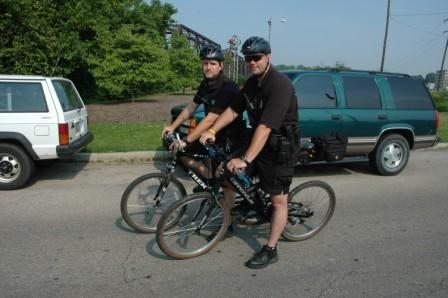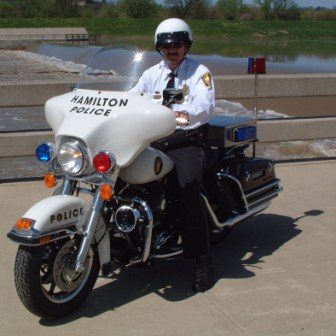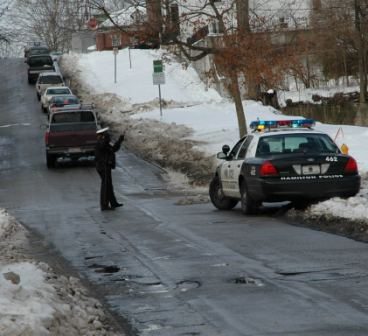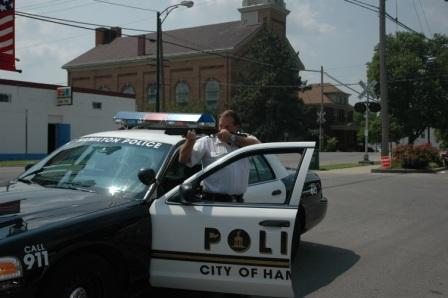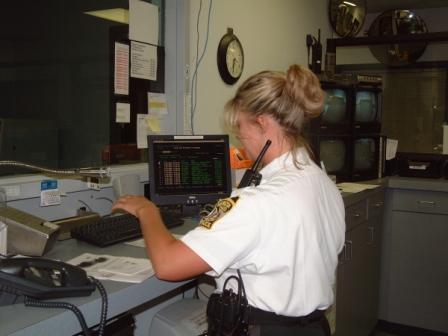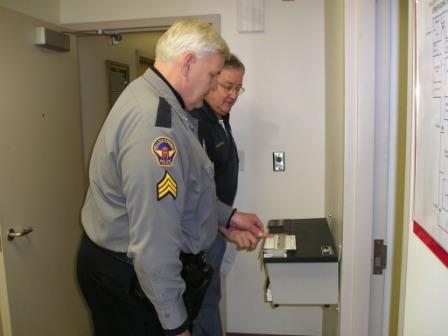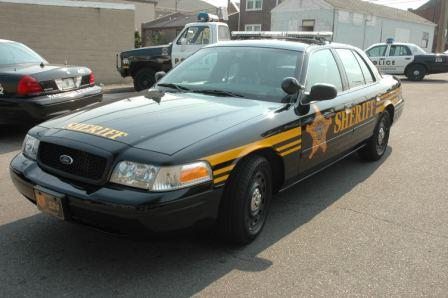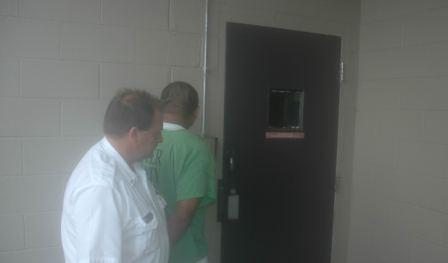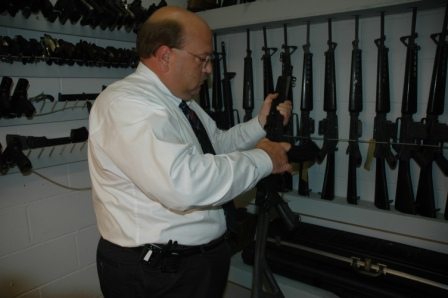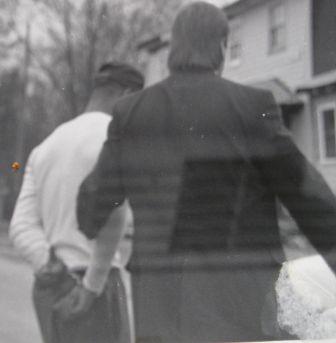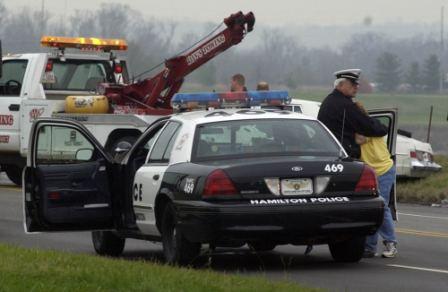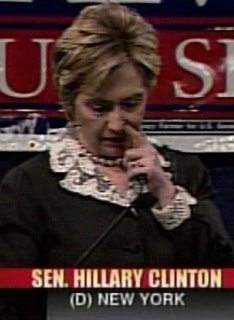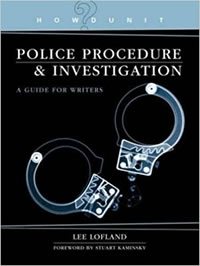Lieutenant David Swords (ret.) is a thrity year veteran of the Springfield, Ohio Police Department. Nearly half of Lt. Swords’ police career was spent as an investigator, working on cases ranging from simple vandalisms to armed robberies and murders.
David is the author of a novel, “Shadows on the Soul.” He and his family live near Springfield.
The Miranda Warning
You have the right to read this blog. If you give up that right – you’ll be sorry!
Anyone who has watched American television for the past forty years can probably recitethe Miranda warning as well as most veteran police officers. You know the routine. Sgt. Joe Friday facing down a wisenheimer suspect, little white card in hand, and spewing out the warning most cops, and half the sixth graders in this country, can say in their sleep.
You have the right to remain silent. Anything you say can and will be used against you in court.
You have the right to speak with an attorney and have an attorney present with you during questioning.
If you can not afford to hire an attorney, one will be appointed to represent you before any questioning, if you wish
Now, for those who might be interested, I typed the above warning from memory, and it’s been over four years since I’ve given it to anyone. It is nice to know my brain hasn’t completely atrophied.
So, where did the Miranda warning come from?
Contrary to what some may believe, Miranda’s first name was not Carmen. No, no, that was the hootchy-kootchy girl with the fruit salad on her head.

The Miranda referred to in the famous Miranda warning was Ernesto Miranda, who was arrested in Arizona in 1963 for rape and kidnapping. He was convicted, based mostly on his confession, but subsequent appeals went all the way to the U.S. Supreme Court. The Court overturned his conviction in 1966 and issued the now well-known Miranda decision, which basically said that persons being questioned by the police should be advised of their Constitutional right against self-incrimination and their right to speak with a lawyer. They must also be told that, if they are indigent, they can have a lawyer appointed to represent them at no cost to themselves.
Miranda was retried and convicted using other evidence that the police had, and was returned to prison. He was paroled in 1972, but his freedom was short lived. Miranda was knifed to death in a barroom cutting scrape in 1976. In what some might call poetic justice, the man taken into custody as a suspect in Miranda’s killing was given his Miranda warning, decided not to answer questions, and was eventually released. It is my understanding the case remains unsolved to his day. Oh, well.
Are all Miranda warnings the same from state to state?
Not exactly.
As I mentioned before, the 1966 Miranda decision was primarily concerned with the right to remain silent, the right to a lawyer, and the right to a government appointed lawyer for indigent persons. The court did not dictate how these rights must be conveyed to a suspect, but only that the person be so advised prior to questioning.
I won’t get into where the familiar word-for-word Joe Friday recitation came from, but suffice it to say that at one point it was all standardized in the familiar warning.
States and agencies can add to, or try to simplify, the warning, as long as the basic warnings are in place. Many agencies add something to the effect of “having these rights in mind, are you willing to talk with me now?”
As for what warning the detective may use in your story, you may wish to call a police agency in the jurisdiction in which your story takes place to find out how they do it. One good way to do research in that area might be to get yourself arrested and see what the police say (just kidding!)
When must the Miranda warning be given?
Remember, if your story takes place prior to 1966, you need not include the Miranda warning. It did not exist prior to that year.
The basic rule of thumb for when Miranda must be used is when a person is suspected of a crime and being questioned while in custody. Usually, custody means at the police station, but a person can be in custody anywhere, even in their own home. What the court will consider is what the police said or did that may have made the person believe they were not free to leave. A person may even feel free to leave from the station house. It’s all in the details.
What happens if a suspect invokes his right to remain silent or wants to talk to a lawyer?
Very simple – you’re done.
If a suspect decides to invoke their right to remain silent, usually by saying something to the effect of, “I ain’t got to talk to you, and you can’t make me,” then you may not continue questioning. You may never re-attempt questioning. The suspect must be the one to reinstitute contact.
When do the police NOT give Miranda?
Have you ever seen a TV show where two uniformed cops chase down a suspect, tackle him, cuff him, and as they are leading him away, one starts reciting Miranda? When you see that, know that officers all over the country are reaching for the remote and switching to “Dancing with the Stars.” You only read Miranda if you are going to question a person concerning a crime. If you see the crime committed, what’s to ask? And you will certainly wait until things calm down if you do wish to question the person.
I can’t tell you how many times I arrested someone and before they were booked into jail, they complained, “You never read me my rights.” To which I answered, “No, and I’m not going to either.” That always made them happy.
Also, any statement a person makes without being prompted by a question, a spontaneous outburst, if you will, is admissible without Miranda. This is a fact lost on some inexperienced officers. Often I have heard officers stop a person that has started to make such a statement to read them Miranda. You feel like choking someone in that situation, and that could make a nice little aggravating episode for your protagonist investigator.
As with all matters of law, I have covered about a tenth of what I could concerning the Miranda warning. In a nutshell, it must be read before custodial questioning of a suspect. If it is not, any statements could be inadmissible in court. Of course, that could put a mad killer back on the street for your detective to hunt down.

Author Bio:
Dr. Katherine Ramsland has a master’s degree in forensic psychology from the John Jay College of Criminal Justice, a master’s degree in clinical psychology from Duquesne University, and a Ph.D. in philosophy from Rutgers. She has published thirty-one books, including The CSI Effect, Inside the Minds of Serial Killers, Inside the Minds of Healthcare Serial Killers, Inside the Minds of Mass Murderers, The Human Predator: A Historical Chronology of Serial Murder and Forensic Investigation, The Criminal Mind: A Writers’ Guide to Forensic Psychology, and The Forensic Science of CSI. With former FBI profiler Gregg McCrary, she co-authored the book on his cases, The Unknown Darkness: Profiling the Predators among Us (Morrow, 2003), and with Professor James E. Starrs, A Voice for the Dead (Putnam 2005), a collection of his cases of historical exhumations and rigorous forensic investigation. She has been translated into ten languages; published fifteen short stories and over 400 articles on serial killers, criminology, forensic science, and criminal investigation, and was a research assistant to former FBI profiler, John Douglas (Mindhunter), which became The Cases that Haunt Us (Scribner, 2000). With FBI profiler Gregg McCrary, she wrote The Unknown Darkness, and with James E. Starrs, A Voice for the Dead, about his various historic exhumations. She currently contributes editorials on forensic issues to The Philadelphia Inquirer; writes a regular feature on historical forensics for The Forensic Examiner (based on her history of Forensic science, Beating the Devil’s Game) and teaches both forensic psychology and criminal justice at DeSales University in Pennsylvania. Her most recent book is Into the Devil’s Den, about an undercover FBI operation inside the Aryan Nations (with Dave Hall and Tym Burkey), and forthcoming are True Stories of CSI and The Devil’s Dozen: How Cutting Edge Forensics Took Down Twelve Notorious Serial Killers. In addition, she has published biographies of both Anne Rice and Dean Koontz and penned three creative nonfiction books about penetrating the world of “vampires” (Piercing the Darkness), ghost hunters (Ghost), and the funeral industry (Cemetery Stories). From these experiences, she wrote two novels, The Heat Seekers and The Blood Hunters. Currently she’s working on a book about murders in her local area.
Dr. Katherine Ramsland:
“You’re not Losing Your Voice, You’re Gaining Another’s”
By Katherine Ramsland
I have been an FBI profiler, a bestselling author of vampire novels, a law professor who digs up the dead, and a tattooed biker from Kentucky, and yet I’m none of these things. I’m a co-author and biographer, and the trick to making that work so everyone’s happy is to create an authentic voice.
To accomplish this – at least for me – it takes intense immersion, wherein over the course of a project I try to experience my day-to-day world through someone else’s perspective. I read what they read, watch what they watch, listen to music they like, meet people they know, and visit places that mean something to them. (For fiction, this means total immersion in your character analysis.) It’s fun, even exciting, but it’s all done in the interest of focus and voice. If I want readers to feel close to the people I’m writing with or about, I must get close to them myself. While this intimate art can risk your sense of balance, if done well you can fully tell a story through a voice not your own.
Let’s consider this notion of a writer’s voice, because it’s foundational to fiction, narrative nonfiction, and even certain technological pieces. Opinion columnists rely on a distinct voice, as do movie and book reviewers. Bloggers certainly need it if they want to maintain interest, and even how-to manuals benefit from a distinct and colorful attitude. So do memoirs, autobiographies and biographies. There’s no need to belabor the point; getting the voice right matters. It defines how characters, real or imagined, think and speak.
Voice conveys attitude, motivation, and credibility, providing the tone through which character and setting are rendered. If you have multiple points of view, as I did with the duo-memoir of Into the Devil’s Den, you work doubly hard to become both people. (The same holds true for multiple points of view in fiction.) You must learn their belief systems, their typical word choices, their cultural background, the parameters of their experience and education, and even how they use words in a sentence. Ultimately, it’s the attitude that makes each voice distinct.
Before describing how I developed the voices for this book, let me first give some context. The F.B.I., just recovering from the 1995 Oklahoma City bombing, was expanding its domestic terrorism program and needed informants to infiltrate the Aryan Nations, the most dangerous white supremacy group in the country. Special Agent Tym Burkey worked out of Ohio, where a particularly fiendish AN member, Ray Redfeairn, was using his pulpit to connect with other white power groups. Burkey needed someone who could win over these paranoid militants, and circumstances brought him together with Dave Hall, a tattooed, 350-pound, six-foot-four former biker with a photographic memory and a firm sense of decency. Hall agreed to take the job
As he penetrated this violent society of hate mongers, he looked to Burkey to watch his back, while Burkey prayed that Hall would not be seduced by Redfeairn’s manipulations. Neither quite knew what to expect from the other, so to convey this tension the story unfolds through their shifting perspectives, and the way their partnership evolved into an unlikely friendship sets Into the Devil’s Den apart from every other undercover tale. In the process, they helped stop another major bombing and an assassination.
To “dance with the devil,” Hall developed innovative strategies to maintain his role and avoid being “erased,” even as it battered his health and cost him relationships. He learned the specialized vocabulary, gestures, and mannerisms expected of insiders, and had to deal with suspicious members who tested his loyalty. Because he was so good at it, he earned several promotions, which gave him unprecedented access to the top brass. Here’s where the need for distinct voices occurs: What Burkey relates about the group that Hall infiltrates heightens the sense of suspense, because the reader gets privileged access to information – and awareness of danger – that Hall does not know. The necessity for him of working blind spices his side of the tale with a heightened anxiety that only Burkey’s friendship can assuage. Burkey just hopes he can keep Hall alive.
The task for me was to take what Hall had written as a daily journal and shape it into a suspenseful story with a clear narrative structure. Then I interviewed Burkey and sent him questions for written answers so that, in strategic places, I could slice in his perspective to advance the story without impeding the pace. That meant getting Burkey to talk about his feelings, too, because he had to grow beyond his role as an agent and come alive as a person. Hall’s was the easy voice, because he wrote the way he talked, in a good ol’ boy manner that was effortless to absorb. Burkey’s personality was more formal, although he was very easy to talk to as well, but it required more attention. The great thing about these two was how distinct their voices were and my job was to preserve that quality. I did that by making each a foil for the other whenever I could. Response and reaction were key interactions.
There’s one more angle on the mastery of voice I want to mention: protecting the voice through the editorial process. There were things that different editors wanted to change and sometimes I accepted that, but often I had to call Burkey or Hall, because I sensed the request violated who they were. Putting words into Burkey’s mouth that he’d never say, for example, or eliminating a peculiar phrase that Hall naturally used seemed to make them different from who they were, so I was prepared to fight for the integrity of the narrative. Sometimes I lost, but mostly I used the writer’s trusty friend, “stet” (leave it alone!), and got it through.
Although writing this book was a real challenge, it has been one of my most interesting experiences as a co-author. I’d already penned two biographies via my immersion method and had co-written four books, so I had some experience with losing my voice and acquiring another’s, but immersing in two people while crafting a story’s structure was often daunting. I was the one who decided where Burkey’s voice should cut in, so the pace was fully my responsibility, and sometimes with immersion you lose your perspective. But in the end, it seems to work. Several readers have affirmed it, and I hope many others will feel the same.
It’s not just an undercover procedural, it’s the story of an unlikely friendship: There are amusing moments, poignant ones, and harrowing incidents as Dave Hall and Tym Burkey move together through this treacherous landscape. There’s even a chapter that has made grown men cry (and me, too). But for me, it was another step in the art of crafting voice and privileged access to two men who bravely made a significant difference. Thanks to them, the AN took a critical blow from which it may never fully recover.
Please visit Dr. Katherine Ramsland
at
***
Into The Devil’s Den: How an FBI Informant Got Inside the Aryan Nations
and a Special Agent Got Him Out Alive
by Dave Hall, Tym Burkey, and Katherine Ramsland (Ballantine, April 2008).
I’m in Witchita, Kansas at the Scene of the Crime conference, so this week’s Weekend Road Trip will be hosted by author Terry Odell. She’s decided to take you guys to Pikes Peak, Colorado for a tour of the Garden of the Gods. Terry promises to have you back in time for our visit on Monday with publisher Ben LeRoy. Enjoy.
Photography by Jason Odell http://www.luminescentphoto.com/
* Tomorrow (Monday April 14): Publisher Ben LeRoy On The Importance of Introductions
Tuesday – Author/police secretary Joyce Tremel on Civilian Police Employees
Wednesday – World renowned forensic psychologist Dr. Katherine Ramsland. Dr. Ramsland has written over two-dozen books, including The C.S.I. Effect, The Human Predator, and the biographies of Dean Koontz and Anne Rice.
Next week: New York Times bestselling author Allison Brennon, Literary Agent Scott Hoffman, and author Martha Alderson.
Sometimes, we just seem to get our tangs all tonguled up and use the wrong words in our stories. Perhaps we learned those incorrect little language units while watching television, or while reading a novel written by a die-hard CSI fan. Either way, here’s some words and facts about DNA that all writers should know if their stories involves this area of forensics.
Terminology
ABI 310 Genetic Analyzer – capillary electrophoresis instrument used in laboratories for DNA testing.
Allele – an alternate form of a gene, such as hair color and the shape of your nose.
ASCLD – American Society of Crime Lab Directors.
Autoradiogram – a sort of x-ray picture of where radioactive probes have adhered to alleles. (It’s a picture of someone’s DNA).
Band – a picture of a DNA fragment.

Capillary Electrophoresis – a method of separating DNA using straw-like capillaries.

The scientist is pointing to the eight capillaries.
Chromosome – a very large piece of DNA.
Males have one Y and one X chromosome. Females have two X chromosomes.
CODIS – Combined DNA Index system. Established in 1998.
Degradation – chemical or physical breakdown of DNA.
Electrophoresis – method of separating DNA molecules using an electric field.
Gel electrophoresis
Electropherogram – A plotted printout of DNA test results.

Gel – medium used in electrophoresis to separate DNA.

Loading DNA into gel.
Genome – an organism’s genetic composition.
Locus – Location of a gene on a chromosome. (pl. Loci)
Mitochondrial DNA – DNA transferred only from mother to child.
STR – repetition of four tandomly repeated nucleotides. The FBI typically uses 13 STR loci in forensic analysis.
DNA Facts:
Identical twins have identical DNA.
Humans are genetically 99.9% identical. Only 0.1% of our genetic makeup is different.
It takes about eight hours for one cell to copy its own DNA.
Red blood cells do not contain DNA.
DNA is used to determine pedigree in livestock.
DNA is used to authenticate wine and caviar.
Detergent and Alcohol will not destroy DNA.
DNA can be transferred from article of clothing to another, even in a washing machine. This is called secondary and tertiary transfer.
DNA testing is not 100% accurate.
Criminal cases involving DNA evidence are usually quite serious in nature (homicide, rape, etc.). Less than 1% of that DNA evidence is reviewed by defense attorneys.
*Want to know what it’s really like to work The Graveyard Shift in a busy police department? Find out tomorrow when romance author/police dispatcher Tracy Seybold stops in for a tell-all visit.
I’m here undercover.
Lee Lofland thinks he invited me over to do a guest stint on his blog. What I’m really doing is getting to know you, his readers, and worming my way into your good graces. Why? Cause I just sold a book about female police officers and when it comes out next year my author is going to be promoting it to police officers, former police officers and people interested in reading about them.
So why am I here a year early? Those who know me might say cause it takes a year for anyone to think I’m charming or a year to not think I’m a sarcastic (um…Lee…can I say bitch on your blog??) but that’s only half the answer.
Blogging is just a new form of word of mouth, and building relationships for effective word of mouth, in the blogosphere as elsewhere, takes time. There are no shortcuts. There aren’t lists of big time bloggers, with their email addresses, and the kinds of things they like to hear about. Newp. This is research one click at a time. Blogroll after blogroll. Thank god for bookmarks and RSS feeds to help keep track of things but it’s still tedious work.
Tedious, but essential. I believe the day of the physical book tour is coming to an end. With the high price of gas, authors spend even more money on what was largely building good will rather than one which sold a lot of books. Fewer authors are willing to do that. Fewer publishers are willing to pay for it. That makes sense from their point of view of course, but it makes promotion and visibility all that much harder.
Word of mouth marketing online is going to do nothing but grow. It’s not going to grow through social networks like Facebook or MySpace either. Those are so sprawling, and devoid of useful content and so clearly self-serving that, as a marketing ploy, they are basically useless. Effective online marketing is through blogs like this. Lee provides interesting content – content we come back to read daily or weekly. When/if Lee finds a book he likes and wants to talk about, and mentions it on his blog, I’ll see it. I’ll pay attention to it because Lee is someone I like, and read. He’s an effective advocate because I have the sense I know him by reading his blog.
If I see a book once on Lee’s blog, that will be nice. But if I see the book again on three other blogs, then I’ll start to remember. Market research tells us that consumers need to see something 12 times before the image “sticks.”
As an author, what that means is that you have to start early. Get to know bloggers in your area. Not geographical area (although that is another good place too) but in your area of writing. If you’re writing about cops, you check out cop blogs. Like this one. And you read it regularly. You offer a comment periodically so your email address or posting name gets known. You become part of a community essentially.
The trick is that it takes time. You can’t just barrel in and announce you’re everyone’s friend and aren’t they lucky you have a book out now for everyone to buy. Well, you could. But I’m trying to be effective, not stupid. I get those emails a lot from people. I routinely delete them without reply. Every other blogger I talk to does the same thing. I see those kinds of posts on listservs I belong to, and I skim right over it as the ineffective mention that it is.
The books I do mention on my blog, are by people I know, and like, and want to promote. The books I do notice on listservs are those talked about by actual readers as books they liked (or sometimes didn’t–I am always intrigued when people rant about a book.)
I firmly believe this is the marketing template of the future. And not just for authors at small publishers, for ALL authors.
And now, back to my clever surveillance plan.
***

*Janet Reid is a literary agent a literary agent with FinePrint Literary Management in New York City. She specializes in crime fiction. You can vist her at http://jetreidliterary.blogspot.com/
Narcotics officers spend a great deal of time conducting surveillance in some of the worst places imaginable, and they do it while enduring some pretty rough conditions. After all, it’s not pleasant sitting in a patch of poison ivy during a rainstorm while watching a bad guy conducting his business. And, the narcotics officers never know if they’ll be discovered, which could lead to a violent confrontation, possibly even a shootout.
Once the surveillance is over, and officers have established the necessary probable cause for obtaining a search warrant, it’s time to locate and seize the evidence. Tactical teams rehearse for this moment over and over again.
Entry team serving a search warrant
Bale (or brick) of marijuana discovered during a search
Twenty-five pounds of freshly harvested marijuana
Back at the police department, officers deposit evidence, such as narcotics, into an evidence safe. Once the items have been placed into the opening on the top of the safe they cannot be removed except by the property room supervisor.
Safes, like the one pictured below, are used during the nighttime hours when the property room officers are off duty. Each morning the property room officers remove the items, catalogue them, and place them into the property warehouse, or other storage facility. Some evidence rooms are huge, like the warehouses in stores like Target,Walmart, and Lowes.
Evidence safe
Property room supervisor weighing a bag of marijuana. No one has access to the evidence except the officers who work inside. If officers need a piece of evidence, they must sign for it much like you would do when checking out a library book.
Scales for weighing evidence. The weight is recorded on the yellow evidence tag along with other pertinent case information.
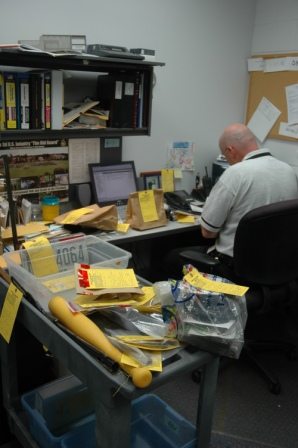
Evidence waiting to be catalogued
After a drug case has made its way though the courts, the drugs are destroyed.
Device used for destroying (burning) narcotics
Photos below are of officers destroying confiscated marijuana.
There’s one job within the police department that really takes special skills, patience, and abilities. It’s a demanding job that requires long, late-night hours, working in extremely dangerous situations, and hanging out with some of the worst criminals in the country. The job – narcotics officer.
Police departments take drug crimes seriously, and they take a proactive approach to locating and arresting illegal drug dealers and manufacturers. One reason they take such as hard stance against illegal drugs is because drug activity is often the cause of other major crimes, such as prostitution, larceny, rape, robbery, and even murder.
Drug crimes often spill over from one jurisdiction to another, so in order to better combat the illegal activity police agencies sometimes join together to form a drug task force. These task forces are often comprised of members from local police departments, sheriff’s offices, state police departments, DEA, FBI, ATF, etc. The officers in these task forces have jurisdiction anywhere within each of the member’s home county, city, or state.
Task force members receive specialized training in drug recognition, proper search warrant service, high-risk entries, undercover operations, drug slang and terminolgy, pharmaceuticals, and other areas relating to drug use and abuse. They’re also trained to locate marijuana growing operations.
To locate outdoor marijuana growing operations, police look for certain things, such as:
– Farm paths that have locked gates.
– Water jugs and fertilizer that’s been strategically placed along footpaths.
– Well-worn footpaths.
-People who regularly visit isolated woodlands.
To locate indoor growing operations, police look for:
– Air-conditioned outbuildings
– Outbuildings with plumbing and electricity.
– Stacks of potting soil and fertilizer
– Unusually large purchases of fertilzer, grow lights, and potting soil.
– Unusually high utility bills.
Indoor growing operation
Officers spend lots of time walking through wooded areas and other prime locations during the marijuana growing season. They also use helicopters and small planes to fly over suspected growing areas. Marijuana has a distinctive blue-green coloring that’s quite visible from the air, even in thick, wooded areas.
Looking down on marijuana plants from police aircraft
Marijuana plants stand out from the surrounding brush. Also, footpaths leading to the crop are like flashing neon lights to officers. Some growers attempt to hide their crops by draping camoflaged netting over their plants. They also grow individual marijuana plants in plastic five-gallon buckets so they can move the entire plant if they think the police may be getting close to their operation.

Confiscated marijuana
Drug task force shoulder patches:


Police officers have a dangerous job, no doubt about it. They drive fast, dodge bullets, wrestle bad guys, and take knives away from rowdy drunks. But, if you take the time to look closely you’ll see that they’re just people, like you and me. They just happen to wear a uniform and carry a gun.

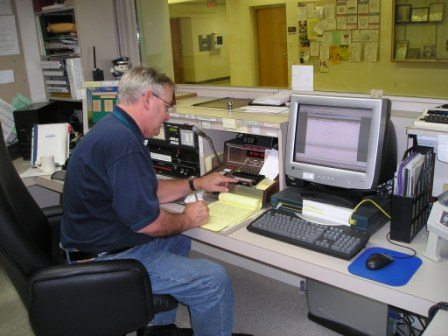

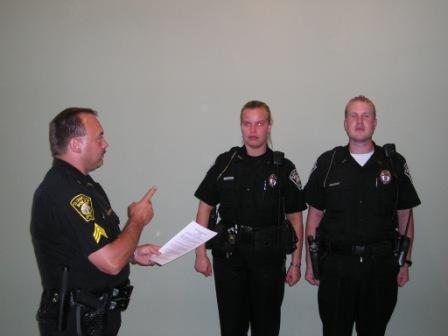
OLYMPUS DIGITAL CAMERA
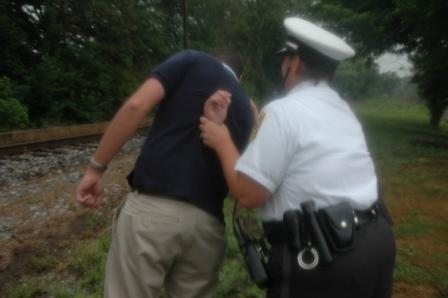


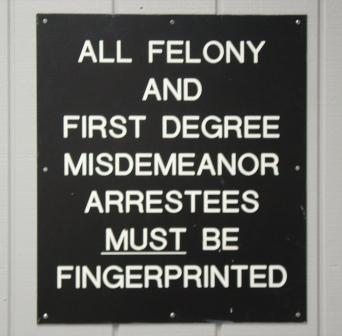


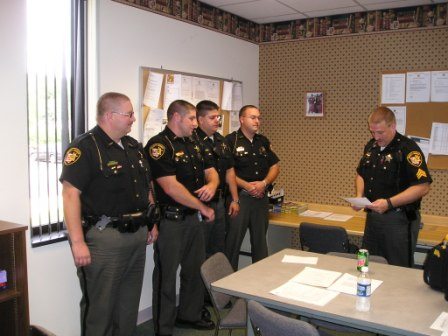
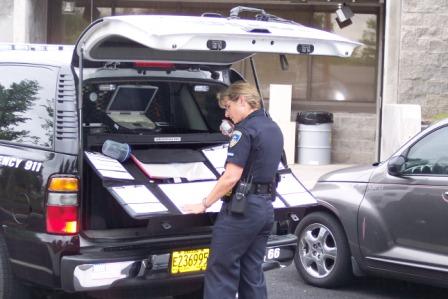
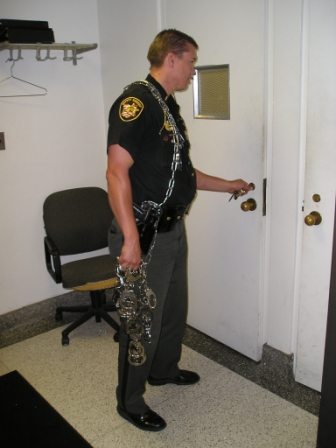
Kinesics is the study of nonverbal communication – body language. A suspect’s movements and gestures can tell investigators when he is being less than truthful. Some of these gestures are very slight while others are as plain as the nose on the suspect’s face.
Liars:
– Like to take up as little space as possible. To do so, they limit their arm and hand movements. They feel safer keeping their hands and arms close to their body.
– Movements are stiff and unnatural.
– Don’t like to make eye contact.
– Repeatedly touch their face, ears, and throat.
– Don’t like to touch their heart or chest area with an open hand.
– Repeatedly touch their nose or ears.
– Timing of gestures are delayed.

– Liars often use gestures that don’t match their verbal responses to a question (frown when they should smile).
– Guilty people are most often defensive.
– A guilty person likes to place an object (a pencil, paper, etc.) between himself and the officer as a protective barrier.
– Liars like to use the officer’s words to answer the question. (repeat the question before responding).
– Liars use contractions (I didn’t do it). Innocent people do not.
– Liars are not comfortable with silence. They ramble, and detectives should allow them to do so.
– Liars mumble and speak in monotone.
– Guilty people love it when detectives change the subject. They immediately become happy. Their sullen moods return when the detective returns to the subject at hand. Investigators intentionally switch topics as a ploy during interrogations.
– Liars and guilty people often use humor in their responses.

Countdown to 2024 KILLER CON
Writers’ Police Academy
The 2024 Writers’ Police Academy is a special event called Killer Con, which is designed to help writers create stunning realism in their work, Killer Con focuses on the intricate details surrounding the crime of murder and subsequent investigations.
Visit The WPA website to register!
*The Writers’ Police Academy (WPA) is held every year and offers an exciting and heart-pounding interactive and educational hands-on experience for writers to enhance their understanding of all aspects of law enforcement, firefighting, EMS, and forensics.
Get to Know Lee Lofland
Lee Lofland is a nationally acclaimed expert on police procedure and crime-scene investigation, and is a popular conference, workshop, and motivational speaker.
Lee has consulted for many bestselling authors, television and film writers, and for online magazines. Lee has appeared as an expert on national television, BBC Television, and radio shows.
Lee is the host and founder of the Writers’ Police Academy, an exciting, one-of-a-kind, hands-on event where writers, readers, and fans learn and train at an actual police academy.
To schedule Lee for your event, contact him at lofland32@msn.com

